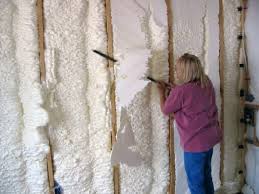
The Benefits of Polyurethane Foam Insulation
Polyurethane foam insulation is a versatile and effective solution for improving energy efficiency in buildings and homes. This type of insulation is known for its excellent thermal performance, durability, and ease of installation. Here are some key benefits of using polyurethane foam insulation:
Energy Efficiency
Polyurethane foam insulation has a high R-value, which means it provides superior thermal resistance compared to other types of insulation materials. By reducing heat transfer through walls, roofs, and floors, polyurethane foam helps maintain a comfortable indoor temperature while lowering heating and cooling costs.
Air Sealing
Unlike traditional insulating materials like fiberglass or cellulose, polyurethane foam insulation expands to fill gaps and cracks in walls, ceilings, and floors. This creates an effective air barrier that helps prevent drafts and air leakage, improving indoor air quality and reducing energy waste.
Moisture Resistance
Polyurethane foam insulation is resistant to moisture infiltration, making it ideal for use in damp or humid environments. Its closed-cell structure prevents water vapor from penetrating the building envelope, reducing the risk of mold growth and structural damage caused by moisture buildup.
Durability
With proper installation and maintenance, polyurethane foam insulation can last for decades without losing its effectiveness. Its strong adhesion to building materials ensures long-term performance, making it a cost-effective investment for property owners looking to improve energy efficiency and comfort levels in their buildings.
Versatility
Polyurethane foam insulation can be applied to various surfaces and shapes, making it suitable for a wide range of construction projects. Whether used in walls, roofs, attics, or foundations, polyurethane foam can conform to irregular spaces and provide seamless coverage for maximum thermal protection.
In conclusion, polyurethane foam insulation offers numerous advantages for enhancing the energy efficiency and comfort of buildings. Its superior thermal performance, air sealing properties, moisture resistance, durability, and versatility make it a popular choice among architects, builders, and homeowners seeking sustainable solutions for their construction projects.
Understanding Polyurethane Foam Insulation: Composition, Functionality, Advantages, Environmental Impact, and Installation Costs
- What is polyurethane foam insulation?
- How does polyurethane foam insulation work?
- What are the benefits of using polyurethane foam insulation?
- Is polyurethane foam insulation environmentally friendly?
- How much does it cost to install polyurethane foam insulation?
What is polyurethane foam insulation?
Polyurethane foam insulation is a type of insulation material that is widely used in buildings and homes to improve energy efficiency and thermal comfort. It is a versatile product that comes in two main forms: rigid foam boards and spray foam. Polyurethane foam insulation has excellent thermal performance, meaning it helps prevent heat transfer through walls, roofs, and floors, thereby reducing heating and cooling costs. Its ability to expand and fill gaps makes it an effective air barrier, preventing drafts and air leakage. Additionally, polyurethane foam insulation is durable, moisture-resistant, and adaptable to various construction applications, making it a popular choice for those looking to enhance the performance of their building envelope.
How does polyurethane foam insulation work?
Polyurethane foam insulation works by creating a continuous thermal barrier that helps regulate heat flow in buildings. When applied, the liquid foam expands and fills gaps, cracks, and cavities in walls, ceilings, or floors. As it cures and hardens, polyurethane foam forms a seamless layer that effectively blocks the transfer of heat through conduction and convection. This insulation material has a high R-value, which indicates its ability to resist heat flow, thereby reducing energy consumption for heating and cooling purposes. By creating an airtight seal and minimizing thermal bridging, polyurethane foam insulation helps maintain consistent indoor temperatures, improve energy efficiency, and enhance overall comfort levels within the building.
What are the benefits of using polyurethane foam insulation?
Polyurethane foam insulation offers a multitude of benefits that make it a popular choice for enhancing energy efficiency and comfort in buildings. One key advantage is its high thermal resistance, which helps to reduce heat transfer through walls, roofs, and floors, resulting in lower heating and cooling costs. Additionally, polyurethane foam insulation provides excellent air sealing properties by filling gaps and cracks to prevent air leakage, improving indoor air quality and overall energy savings. Its moisture resistance capabilities make it ideal for damp environments, while its durability ensures long-lasting performance without compromising effectiveness. The versatility of polyurethane foam allows for easy application on various surfaces and shapes, making it a versatile solution for a wide range of construction projects.
Is polyurethane foam insulation environmentally friendly?
Is Polyurethane Foam Insulation Environmentally Friendly?
Polyurethane foam insulation can be considered environmentally friendly when its energy-saving benefits and long-term durability are taken into account. While the production process of polyurethane foam may involve some chemicals, its high thermal performance helps reduce energy consumption for heating and cooling, thereby lowering greenhouse gas emissions. Additionally, the long lifespan of polyurethane foam insulation minimizes the need for frequent replacements, reducing waste generation. When properly installed and maintained, polyurethane foam insulation can contribute to a more sustainable built environment by improving energy efficiency and reducing overall environmental impact.
How much does it cost to install polyurethane foam insulation?
When considering the cost of installing polyurethane foam insulation, several factors come into play. The overall cost can vary depending on the size of the area to be insulated, the type of polyurethane foam used (such as open-cell or closed-cell), and the complexity of the installation process. Additionally, factors like labor costs, location, and any additional materials required for preparation and application can impact the total expenses. While polyurethane foam insulation may have a higher upfront cost compared to traditional insulation materials, its long-term energy savings and benefits in terms of efficiency and durability often make it a worthwhile investment for property owners looking to enhance their building’s performance and comfort levels.
